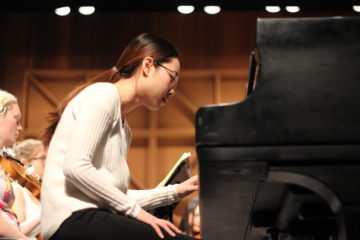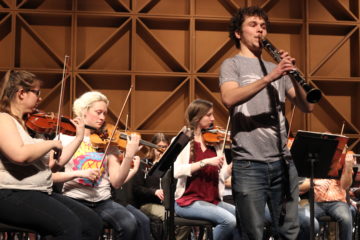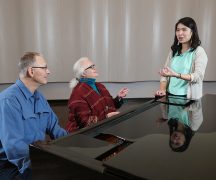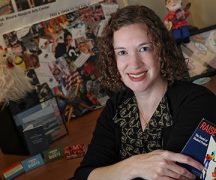By DAVID DUPONT
BG Independent News
The soloists in Saturday’s concerto competition didn’t make it easy for their fellow students in The Bowling Green Philharmonia.

Kenneth Cox with conductor Maria Mercedes Diaz rehearse.
Flutist Kenneth Cox said the orchestra parts have more notes than his solo part. And the solo part in Joan Tower’s Flute Concerto has plenty of notes jammed into its measures.
Cox, who studies in the Bowling Green State University College of Musical Arts doctorate in contemporary music program, executes them with aplomb with the orchestra keeping pace.
Michelle Whitmore said she’s heard from some orchestra members about some of the unusual sounds the score of her piece requires of them.
But that’s what they should expect when the piece is John Corigliano’s “The Pied Piper Fantasy,” and they get to be the rats.
Whitmore gets to make her entrance strolling through the orchestra.
The program is no stroll in the park for the orchestra. Emily Freeman Brown said this was the most difficult concerto concert set the Philharmonia has tackled. And they’ve risen to the challenge.
Tonight (Saturday, Feb. 25) at 8 p.m. in Kobacker Hall in the Moore Musical Arts Center on the Bowling Green State University campus the Philharmonia will perform with the four winners of last December’ 50th Competition in Musical performance. Tickets are $10.

Pianist Peisi Luo
Beside Cox and Whitmore, those performing will be junior Stephen Dubetz on clarinet performing Stephen Hartke’s Clarinet Concerto “Landscape in Blue” and graduate student Peisi Luo soloing on Maurice Ravel’s Piano Concerto for left hand.
Each earned the honor of soloing with the orchestra by coming out on top of competition with 69 of the best musicians in the college.
For Whitmore, a senior performance major, this was the first chance to solo with an orchestra. The experience, she said, is at once “terrifying” but also “really, really exciting to hear the different textures.”
She has loved the piece since she was a freshman and heard another flutist play it. She was impressed by its theatricality. Whitmore decided she wanted to learn the piece when she was “good enough.”
Now she’s contemplating continuing her flute studies in graduate school. She’s auditioned and is awaiting the results. So far she’s been accepted by the Royal College of Music in London.
As a child flute was not her first choice of instrument. Originally she wanted to play drums, but her family vetoed that. So she played a friend’s flute and fell in love with that. She was drawn to BGSU by the chance to study with Conor Nelson. Of all the teachers she encountered during her college search, she said, “he was the most artistic, the most vibrant musician.”

Stephen Dubetz
Dubetz also had another instrument in mind when he started band in sixth grade. He wanted to play flute, but when he tried to blow it he couldn’t get a sound, so he got discouraged.
His mother, who had played clarinet, encouraged him to try that instrument, and he had more success. Though he only joined band because his friends had, it turned into something more. Now he’s a music education major in his junior year. He selected BGSU after his audition with Kevin Schempf. Somehow, he forgot the thumb guard on his clarinet on the music stand in Schempf’s studio. Schempf sent it back to him with a note.
That human touch was enough to make up Dubetz’ mind, and he has not regretted the decision.
Dubetz choose the jazz concerto by Hartke because Schempf recommended it. “It’s a fun, out of the box piece that matches my personality,” he said.
He’s looking forward to going to graduate school in performance, and then starting his career with a stint in an Armed Forces band.
Luo, a first year graduate student in piano and pedagogy, was also attracted the BGSU by a connection with a teacher. She met Thomas Rosenkranz in China and decided to come to the United States to study with him.
Having attended music school in China since she was 11, she wanted to expand her musical experience and study in a different system.
Her selection of Ravel’s concerto for left hand has its roots 10 years ago. She was 12 when she twisted her right wrist. Her teacher suggested she work on pieces written for the left hand only. Later a teacher introduced her to the Ravel piece, but at that point she wasn’t up to the challenge.
Now in her first year, she is ready. The piece written for a pianist who lost his right arm in World War I, requires a balancing act as the pianist must shift her center of gravity. The concerto requires the left hand to carry both the melody and harmony. The petite pianist has to work she said, to generate the strength and power to carry this off.
Cox already has an established career as a performer, but he also has a passion for teaching and a doctorate is necessary to pursue that. “It’s my honor and duty to pass on what my teachers have taught me,” he said.
He was attracted to BGSU for several reasons. He wanted to study with Nelson, whom he called “an amazing musician.” And BGSU is one of only two universities that has a doctorate with a specialty in contemporary music.
Cox decided on performing the Tower concerto from 1992 because it is seldom performed with orchestra. He estimated it’s been played with full orchestra only seven or eight times.
The piece is difficult for the young orchestra, Cox said. “They like the challenge. It’s been a pleasure to work with them and make it come to life.”





